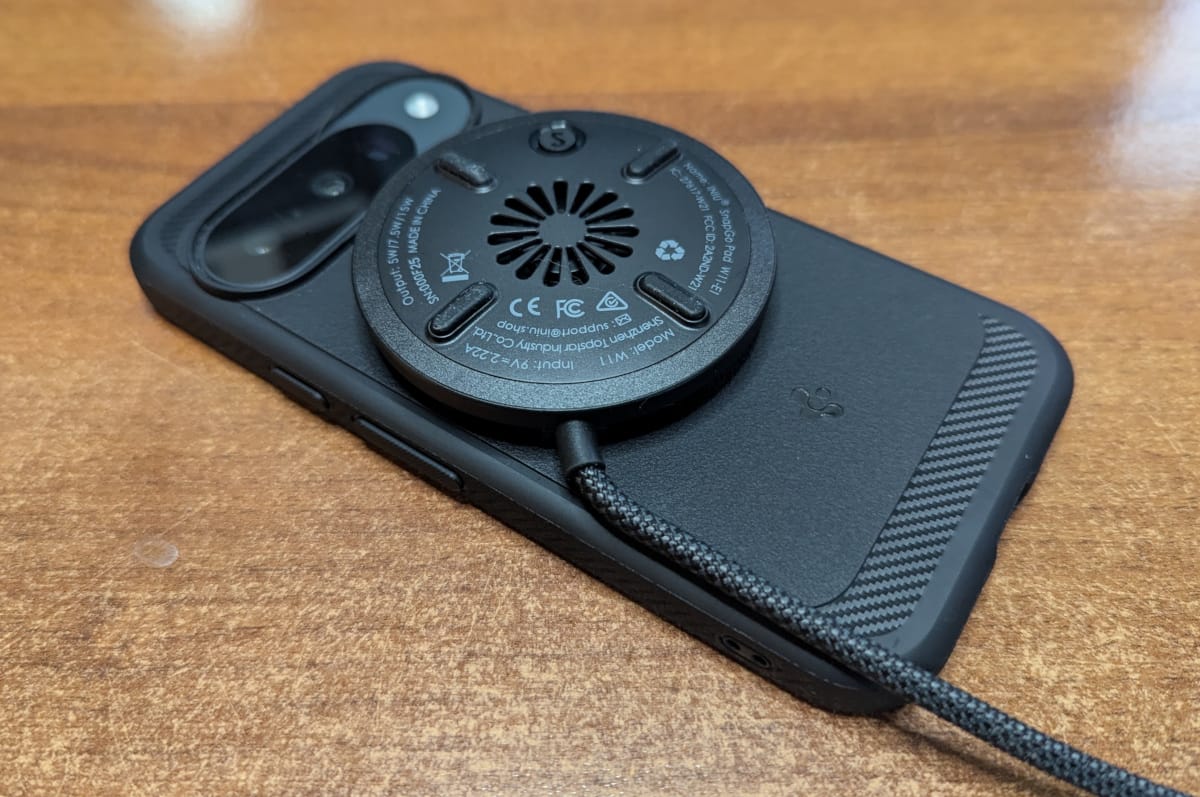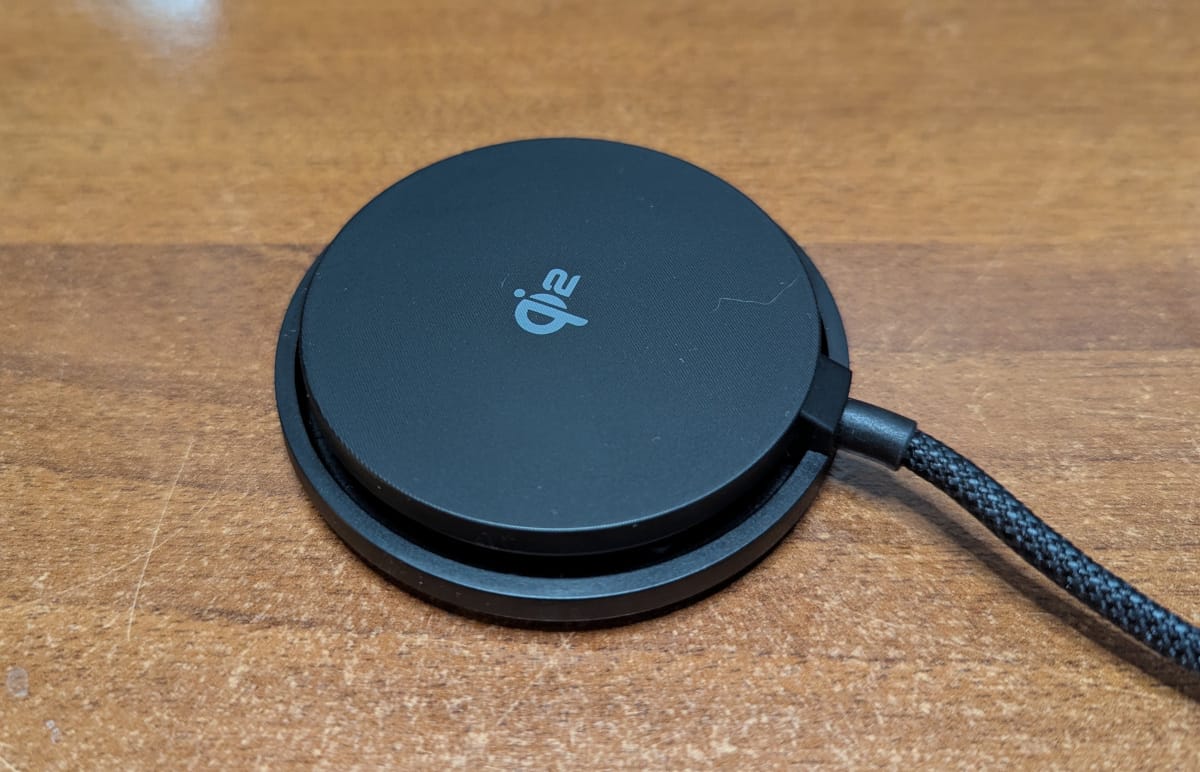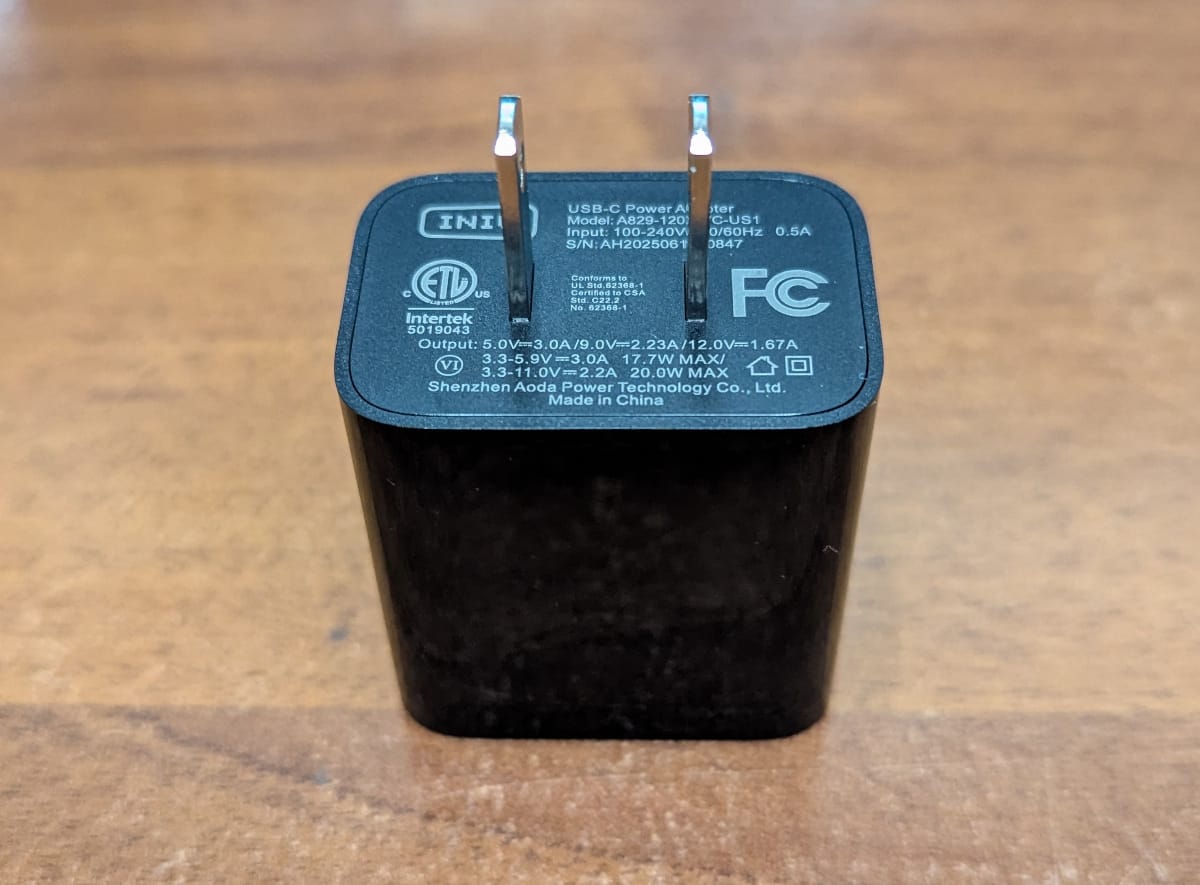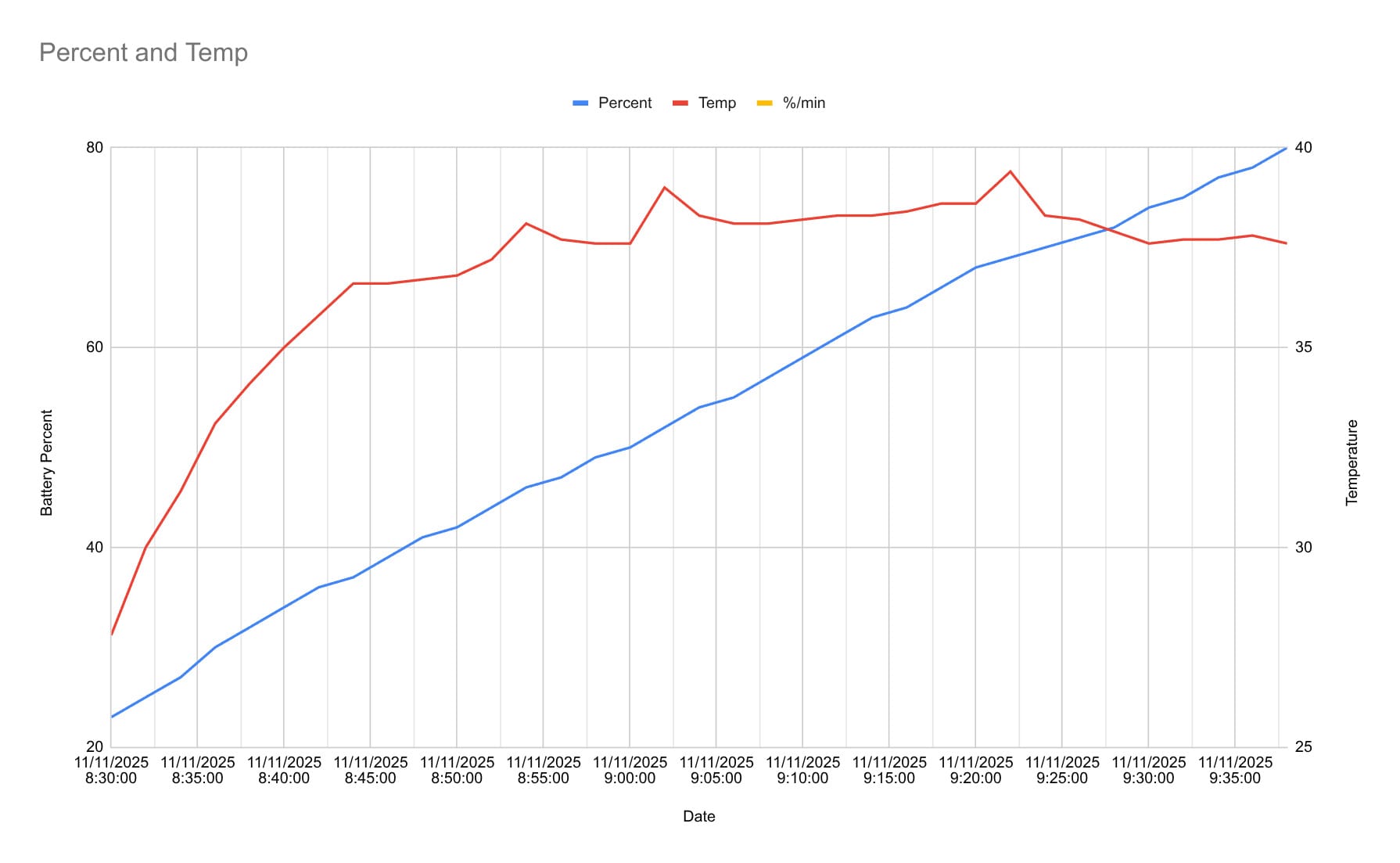INIU Qi2 Certified 15W Mag-Safe Wireless Charger
... with cooling fan! For $20!

After I found that my cheap Qi charger that I had used on my Pixel 3 and 6 wasn't working properly on my Pixel 10, I eventually gave in and got the only charger that seemed high quality and was said to work well with the Pixel 10 series, and that was the Belkin 25W 2-in-1. I have (entirely too many) details about that charger in its article, but to summarize, it's excellent, but I really dislike the battery charging at 40C and realized that I really just wanted a slower charger. I generally only charge the phone once a day, and that is overnight, so charging slowly is perfectly fine, keeps the phone cool, and makes me worry less about battery longevity. And while I am not going to return the Belkin, I do find the $60 price tag pretty high, and I saw a post on Reddit claiming that the INIU charger works great on the Pixel 10, and it's only $20.
I wish I'd known this sooner. It's pretty good and a third of the price, and since the Pixel 10 (and Pixel 10 XL) are limited to 15W wireless charging, buying a 25W charger was overkill. Since I have the Belkin and have done a lot of testing with it, I will be doing a lot of comparisons to that charger in this article.
The Amazon listing for this charger says that it is not for Android phones, but it's likely that it has not been updated since the Pixel 10 came out, and previous Pixel phones did not support MagSafe Qi2. TLDR: It works fine with the Pixel 10.
Design/Features
This is a basic round puck design that, being Mag-Safe (or PixelSnap), attaches itself to the back of your phone in precisely the right location and attaches very securely. It has a low-intensity green light ring around the charging pad and a built-in fan to reduce heat while charging. The 5ft cable is built into the unit and terminates in a USB-C connector and is supplied with a 20W PD wall adapter.

Fan
The fan is super quiet. When I think of a small, low-profile fan, I think of high-pitched noises and the fan sounding strained, but this is very, very quiet. The way it is designed is very simple; it pulls air in through the bottom of the puck, and it winds up blowing out around the charge side of the puck, but it is only moving a small amount of air. The fan inlet is on the bottom of the charger, and it directs air up and then around the charging pad itself, moving just enough air to help cool the phone while charging. The puck has small feet on the bottom so that even with the phone facing up while on a desk, the fan isn't blocked; however, if you're charging on something other than a hard surface, it's likely best if you charge with the phone face down so the fan intake isn't blocked. I will do some testing to see if the charging cycle runs cooler with the phone facing down so the fan potentially has better airflow, but I suspect it won't make any difference.
While charging, you can actually feel air blowing away from the bottom of the phone, particularly if the phone/charger is warm, you can feel the warm air being pushed away. How effective this actually is would probably be hard to measure, even with many test cycles; however, even a small amount of air moving vs static air can help cool things.
In a quiet bedroom at night, you might be able to hear it, but it's likely not a concern even then. On my desk, I can't even hear it running with other ambient noises in the room (PC case fans, etc). When I'm charging the phone using the supplied 20W wall adapter, the fan is slightly louder than when charging off a non-PD 5V charger (more on that later), but it's quiet enough that it doesn't bother me. More on the fan at 5V later. The fan can be turned off using a button on the bottom of the charger; however, this only disables the fan for a single charge and always defaults to on.
One thing does bother me about the fan, however. When the phone completes charging, it doesn't seem to ever turn off until I remove the phone entirely from the charger. I've let it sit on the charger for well over 30 minutes a few times, and the fan was still running. Remaining on for a period to help continue to cool the phone after a charge cycle is good; however, this seems like a design flaw. Once the fan is no longer needed, it should turn off entirely.
And a minor thing; I think the fan turns on when charging rather than being regulated by any kind of temperature sensor, so even charging my Pixel Buds Pro 2, which stay rather cool, the fan came on while charging.
The only other thing to mention about the fan is that over time, fans can fail from ingress of dust, hair, etc, so hopefully, if this happens, it won't affect the charger usage or performance.
Light Ring
Around the top of the puck is a very low-intensity ring of light that comes on for 60 seconds when you plug in the charger and then goes off. When you put a device on the charger, the light comes on for 60 seconds and then goes off. While I prefer nothing creating light in the bedroom at night, I'm not quite sure of the purpose of this light. I initially thought it may be to help locate the charger in the dark, indicate charging status, etc, but no.
The button on the bottom of the charger that turns off the fan also turns off the LED, so it seems that the only point of the light is to indicate that the fan is enabled.
Supplied Wall Adapter
The supplied USB-C PD charger is specified as being capable of 5V3A, 9V2.3A, or 12V1.7A. Has an ETL logo; hopefully, it's real and not just a 'fake' logo. During a charge cycle, the adapter only gets slightly warm.

USB Cable
The cable is built into the charger, and even though I would prefer the charger to have a plug so that I could use any USB-C cable, the included cable feels pretty good, not too stiff, not too thin, and has a braided sheath.
Charging Tests
Supplied 20W Charger
Using my USB power meter, I measured that when charging, 21W is drawn at the USB-C port, 9V at 2.3A. On the phone, I have seen a peak of 3030mAh in Ampere.
On the first test, I charged the phone screen up, as this will likely be how I typically use the charger. I started the charge with the phone at 51%, and ended at 80%. The phone got up to 38.6C, and it charged at .8%/min. Interestingly, even though this is "only" a 15W charger, the Belkin 25W charger charges at .9%/hr on average, but given my Pixel 10 is limited to 15W wireless charging, this makes sense. So, effectively, it charged the same as the Belkin charger.
My second charge cycle was invalid, and I have removed it from the table. Play Store auto-updated apps mid-run, which slowed the charge down and increased the temperature. I say more about this at the end of this article.
In my third charge cycle, I disabled Play Store Automatic updates and saw a more consistent temperature curve that leveled out at about 38.3C and charged at .7%/minute.
Fourth run, not much to mention, consistent charge and temperature curve.
Fifth run, phone face down to see if the fan facing up made any difference in charging rate, temperature, etc. I will likely run this again to make sure (TK), but the temperature curve stayed flat much longer and did eventually reach 38.8C.
| Starting Battery | Ending Battery | Avg %/min | Start Temp | Peak Temp | Total Time | Note |
|---|---|---|---|---|---|---|
| 51 | 80 | .81 | 23.2C | 38.5C | 36 | Run 1, 20W Input |
| 35 | 80 | .75 | 28.8C | 38.3C | 60 | Run 3, 20W Input |
| 23 | 80 | .84 | 27.8C | 39.4C | 68 | Run 4, 20W Input |
| 25 | 80 | .72 | 28C | 38.8C | 76 | Run 5, 20W Input, Face down |

Charging at 5V
I tried charging it from a normal 5V supply using an inexpensive A to C dongle from an Anker 6-port charger, and it works! 5V at 1.3A is what my USB power meter showed, so it was drawing about 6.5W. The phone reported 950mA incoming current in Ampere, which is slow, but overnight, that's perfectly fine as long as the phone stays cool. I'm not sure, but, I think the fan is also quieter at 5V. Charging took 116 minutes, it averaged .3%/minute, and the maximum temperature was 33.1C, but only for a very short period. In reality, most of the time it was under 31C, but for about 15 minutes at around 55% battery, it went up a few degrees, likely from the Play Store updating apps. Again, the fan seemed to stay on after charging, even though the charging puck itself never got warm, and it would have cooled off more in just a few minutes.
Charge cycles 2 and 3 at 5V both stayed about 30C nearly the entire time, except for a 30-minute bump that raised the temperature to 33C on cycle 2 and 31.2C on cycle 3, approximately 30 minutes in the middle of the charge cycle. After that, it dropped back down and averaged around 29C. Not entirely sure what to make of this temperature increase.
Run 4, I left the fan on, and while the fan noise is so quiet I didn't notice it at all, it also didn't appear to really make any difference in the temperature peak or graph.
I suspect that running on 5V, you can turn the fan off without any real difference in temperature while charging, since it's so slow, which is perfect for overnight.
I have tested the Belkin on 5V, and it will not charge at all.
| Starting Battery | Ending Battery | Avg %/min | Start Temp | Peak Temp | Total Time | Note |
|---|---|---|---|---|---|---|
| 42 | 80 | .3 | 24.7C | 33.1C | 116 | Run 1, 5W Input |
| 48 | 80 | .33 | 29.0C | 33.1C | 96 | Run 2, 5W Input no Fan |
| 34 | 80 | .33 | 30.1C | 31.2C | 138 | Run 3, 5W Input no Fan |
| 16 | 80 | .36 | 30.6C | 31.3C | 180 | Run 4, 5W Input, with Fan |

Charging Pixel Buds Pro 2
The Belkin has a secondary 5W charger, which is handy if you need to charge the phone and earbuds at the same time, but the INIU charger is capable of charging the earbuds by themselves and at the same charging speed as the Belkin charger would. The fan comes on during charging, even though things stay cool.
Interestingly, this will also charge my Pixel 6 at a 500mA charge rate. I probably would not buy this charger for a Pixel 6, but in a pinch, it will work.
Wait, why is this not charging?
During my testing, I've put the phone on the charger once (using the supplied 20W charger), and about 30 minutes later, I realized that the battery percentage had not moved. The fan was running, so the charger detected it was connected to the phone, but the phone wasn't charging at all. I looked in Ampere, and it showed the phone was using power as if it were not charging at all, and my Tasker logs show the phone was plugged into AC the entire time and it continued to get warmer for 30 minutes (started at 24C and was 29C when I 'replugged' the charger), but the battery percentage stayed the same the entire time. I removed the puck and put it back on, and then it was fine. I have no idea what happened, but if this ever happens again, this thing is getting returned. During this non-charging period, there was no indication at all that it was not charging, and I only noticed because I checked the battery percent.
Belkin 2-in-1 vs INIU
Since I have the Belkin 2-in-1 25W Charger (really, 3-in-1, if you include the USB-C port), I feel compelled to make some more direct comparisons.
Charging Capabilities
The Belkin can charge your phone and has a 5W wireless and 5W USB-C output that can all be used at the same time to charge multiple devices. The INIU can charge a small device, like the PBP2, at the same speed as the Belkin, although not at the same time as the phone, so if you charge your phone and earbuds every night, the Belkin might be better, having multiple chargers in one.
If you have a Pixel 10 or 10 Pro, the phone itself is limited to a wireless charging power of 15W, so either charger will charge wirelessly at the same speed in theory. In reality, I have seen the Belkin charge at .95%/minute peak and the INIU peaks at .85%/minute. The Belkin does have a 45W PD wall adapter vs the 20W PD wall adapter in the INIU, so if you'll ever use just the wall adapter for the fastest possible charging speed, the Belkin would likely win here.
Battery Temperature While Charging
At 15W charging speeds, both chargers will easily raise the temperature of the phone; however, the INIU, with its built-in fan, seems to keep it a few degrees cooler for shorter charge cycles. However, for longer charges, the phone does get up to nearly 40C. After multiple test cycles, I don't think the fan makes any significant difference in charging temperatures.
For overnight charging, however, the ability for the INIU to run off a standard 5V supply and charge more slowly and stay cooler is a big advantage.
Convenience and Portability
Both magnetically attach as soon as the phone is nearby, but the Belkin would likely win here as the phone is in a vertical standing position and can double as a clock, etc. Both have 5-foot/1.5M long USB cables, but the Belkin has a detachable cable.
As for portability, the INIU wins here for its small puck size; even though its USB cable is permanently attached to the puck, it is still smaller than the Belkin, even when the Belkin is folded.
Comparison Conclusion
The Belkin offers more, but the INIU is more flexible if you care about how fast your phone charges and how much heat it creates while doing so, because it will charge at a lower rate from a 5V source. It is capable of functioning from any charger, it is a third of the price, and it will wirelessly charge a Pixel 10 at the same 15W rate when using the supplied or any other compatible adapter. The Belkin is slightly more convenient to use with its upright stand form factor, and the secondary charger could be useful occasionally.
Price
At the time I'm writing this, the INIU is $20 and the Belkin is $60. Both come with rather good PD wall adapters and are complete packages, unlike some wireless chargers I've seen in the past that require you to have or purchase a separate PD power supply.
Play Store Auto Updates
In case you want to play along at home, I've observed, googled, and confirmed that the Play Store defers auto updates until the phone is at least at 50% state-of-charge. So as soon as the phone hits 50%, it'll download any pending apps and both use battery (slow down charging) but also significantly warm the phone up, throwing off your data. You'll need to turn off automatic updates while testing to get good data.
Battery Health and Charging
I'm aware that there is a YouTube video whose creator did testing on phones and in their testing determined that max charge and charge speed did not indicate excessive wear on the batteries, however, while I realize multiple phones were used in the testing this was only a single test, single tester, and does not consider real time usage of phones nor long term ownership. Battery University will remain my go-to for battery advice, and while I highly suggest you read their pages on your particular devices' battery chemistry, it comes down to a few simple rules. Charge early and often (do not overly discharge regularly), and cooler is better (especially during charge cycles and at higher states of charge).
Conclusion
Both the INIU is a pretty solid charger with a strong magnet, flexible charging speeds, and a compact size. I wish the fan button stored its state and, when disabled, remained disabled; however, since the noise level of the fan is so low, this is really a non-issue. A detachable USB-C cable would have also been nice.
I wish I had purchased the INIU first instead of the Belkin, especially for my daily charge, which is typically done overnight.
